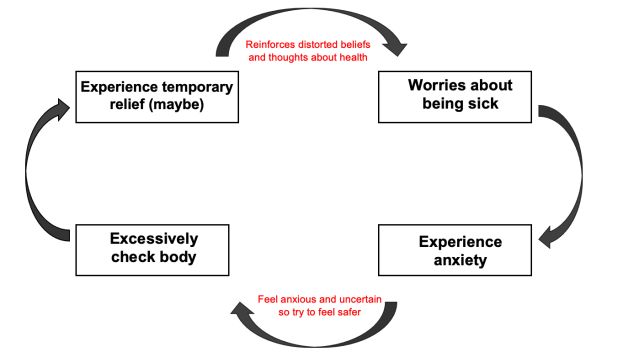When we have health anxiety, we can sometimes fall into the trap of closely monitoring our bodies to look for symptoms or any signs that we are in danger, whether it is a sign that we have a new disease or a sign that an existing disease is worsening or returning.
As a therapist with a personal history of health anxiety, this was a bad habit of mine for a long time. I was like a little “detective,” always working overtime to solve each new case or symptom. It was both exhausting and fruitless. So, what does excessive checking look like?
Examples of Checking Behaviors
- Checking for new concerns (e.g., lumps, moles, discoloration).
- Monitoring heart rate, blood pressure, weight or lung capacity, etc.
- Giving yourself tests/examples (e.g., visual exams, neurological or cognitive tests, physical assessments).
- Inspecting saliva, feces, urine, or other bodily fluids.
- Pushing, pulling, or poking a body part or new symptom repeatedly.
Some checking behaviors are subtle and sometimes not even easy to identify (e.g., paying attention to breathing patterns), while other behaviors are so overt and time-consuming that they can seriously disrupt your daily life.

The cycle of safety behaviors with health anxiety.
Source: Brittney Chesworth
Why Checking Behaviors Are Problematic
Checking behaviors are a type of safety behavior. Safety behaviors reduce anxiety in the short term but increase anxiety over the long term. Essentially, they keep you stuck in a vicious cycle.
- You begin to believe that you need these behaviors to be healthy and “safe.”
- You grow dependent on these behaviors and don’t get the opportunity to see if you would actually be OK without them.
- This body vigilance makes you more likely to find problems and leads to unnecessary concerns.
- They create more anxiety and uncertainty.
- They reinforce problematic beliefs about health and illness.
Recognizing Your Own Patterns
You might have heard me say this in other contexts but developing awareness is a great first step to changing a behavior. Sometimes we have become so used to doing something that we don’t really think about it or recognize it as a problem.
Personally, I’ve done a lot of things on this list throughout the decades that I’ve lived with health anxiety. One thing I often did without realizing it was to check my finger for any twitching in fear that I had a neurodegenerative disease. I would periodically raise my hand and put my fingers in front of me as I walked to double-check that they weren’t twitching. I didn’t really even think about the fact that I did it until my husband pointed it out.
So, what do you do? How do you monitor your body to identify signs of trouble? Some behaviors might immediately come to mind. Others might be less obvious to you. I recommend spending the next week monitoring your behavior. Start with the feeling. When you feel anxious, pause and take note of what you do.
- Do you check or monitor a part of your body?
- Do you check what comes out of your body?
- Do you check your functioning in some way?
Don’t change anything in the first step. Simply observe and write it down. Document all of the little ways you monitor your body as well as how often you do it. Lastly, consider how this behavior impacts you. Does it increase anxiety? Does it take time out of your day? Do you miss out on the present moment because of it? It can be helpful to recognize this process as the first step. You can document all of this in the log below.

Thought record for health anxiety.
Source: Brittney Chesworth
Typically, when I work with clients as a CBT therapist, we first focus on developing awareness of the cycle of problematic thoughts and behaviors. Once my clients have an understanding of their patterns, we take the next step of helping them to challenge thoughts and eliminate problematic behaviors. Begin by monitoring yourself and documenting how this plays out in your life.
To find a therapist, please visit the Psychology Today Therapy Directory.
